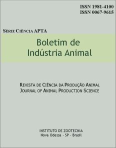Body measurements and carcass characteristics correlation of Nellore young bulls finishidedED IN FEEDLOT
DOI:
https://doi.org/10.17523/bia.v71n4p371Keywords:
biometry, bovines, ultrasonic images, dressing percentageAbstract
In this work it was aimed to evaluate Pearson correlations between body measurements, carcass characteristics and production of 35 Nellore bulls, confined for 96 days, with 402±14.90 kg and 18 months old. Weightings, ultrasound images and 14 measurements were obtained at the beginning of each experimental period and before slaughter, totaling four weight ratings of ultrasound images and measurements per animal. For the evaluation of body measurements and ultrasound images with carcass traits the values from the last measurement were considered. The images were made along with weighing animals through a Scanner, and measurements with a tape measure and a zoométrica cane, and these were correlated with each other and with productive and carcass characteristics. For measures of loin eye area evaluated by ultrasonography, it were found positive correlations with body length (0.32), rump (0.36) and thigh (0.20); withers height (0.20) and pelviano contour (0.38) (P<0.05). Variables of hip height and chest, chest width and pin bones, and heart girth showed positive correlations with two or more productive traits of economic interest, such as slaughter weight, hot carcass weight and dressing percentage (P<0.05). Significant correlations were found for most of the variables studied. Linear body measurements such as length and height emerge as a tool that can be useful in the formation of more homogenous lots and to predict the point of slaughter, along with the weight of the animals.Downloads
Downloads
Published
Issue
Section
License
Os autores não serão remunerados pela publicação de trabalhos, pois devem abrir mão de seus direitos autorais em favor deste periódico. Por outro lado, os autores ficam autorizados a publicar seus artigos, simultaneamente, em repositórios da instituição de sua origem, desde que citada a fonte da publicação original seja Boletim de Indústria Animal. A revista se reserva o direito de efetuar, nos originais, alterações de ordem normativa, ortográfica e gramatical, com vistas a manter o padrão culto da língua e a credibilidade do veículo. Respeitará, no entanto, o estilo de escrever dos autores. Alterações, correções ou sugestões de ordem conceitual serão encaminhadas aos autores, quando necessário. Nesses casos, os artigos, depois de adequados, deverão ser submetidos a nova apreciação. As opiniões emitidas pelos autores dos artigos são de sua exclusiva responsabilidade. Todo o conteúdo deste periódico, exceto onde está identificado, está licenciado sob a Licença Creative Commons Attribution (CC-BY-NC). A condição BY implica que os licenciados podem copiar, distribuir, exibir e executar a obra e fazer trabalhos derivados com base em que só se dão o autor ou licenciante os créditos na forma especificada por estes. A cláusula NC significa que os licenciados podem copiar, distribuir, exibir e executar a obra e fazer trabalhos derivados com base apenas para fins não comerciais.













